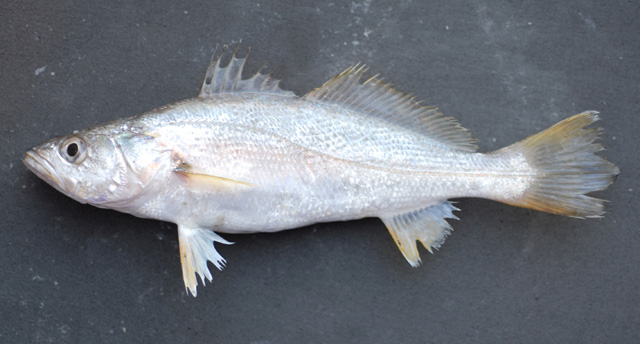What is the Sand Trout?

The Sand Trout, also referred to as the sand seatrout or white trout, is the common name of the Cynoscion arenarius. It's a relatively average species of drum fish most often seen in parts of the Atlantic Ocean and in the Gulf of Mexico, particularly southwest Florida and the Bay of Campeche.
People often mistake the sand seatrout for its cousin the silver seatrout, but in fact, the sand seatrout is quite a bit bigger than its silver cousin, weighing between one and two pounds. It also tends to live further inshore than the silver seatrout.
The other big differences between the two are their colors and their anal fins. The silver seatrout is, of course, silver, while the sand seatrout is yellow or tan in color. The two fish's anal fins are also quite different. The sand seatrout has ten or sometimes even 12 rays on its anal fin; the silver seatrout has nine.
Other cousins of the sand seatrout include spotted seatrout and the weakfish. In fact, some scientists believe the sand seatrout may actually be a subspecies of weakfish that doesn't have spots. The sand seatrout's belly is white, and its most distinctive features are the two fang-like canine teeth in the top of its mouth.
Its spawning season occurs in both the summer and spring months, and these fish are heavy spawners. It's believed they can also cross-spawn with other species of trout to create hybrids.
Where and When Is the Best Time to Fish for Sand Trout?
People often fish for sand seatrout for both sport and for food; however, some times of the year are definitely better for fishing for sand seatrout than other times of the year.
Sand seatrout can most often be caught during their spawning seasons in the summer and spring months. They like warm water and are much more active in these months. They aren't solitary fish, preferring instead to live in schools. They can most often be found in river channels, canals, bays and flats eleven feet or deeper.
Despite their names, sand trout don't only bed down in sand; they can also be found in mud. In addition to bays, they also frequent inshore waters and estuarine waters. They've been found as deep as 300 feet beneath the water. The deeper the water, of course, means the bigger your fish is likely to be. Small fish tend to stick to the shallow waters because they're safer.
Some of the biggest sand seatrouts have been found around gas and oil platforms and rigs. They also flock to artificial ocean reefs, piers and other man-made structures. This is partly due to their strong attraction to light. It's not recommended to fish for sand seatrout in the fall months, but they can occasionally be found in the cooler months if you move into offshore waters.
They can be caught from boats, piers or from the shore.
Fishing for Sand Seatrout
Although they can be found in other places, such as Florida and the Bay of Campeche, sand seatrout is most commonly fished by anglers in Mississippi. In fact, when it comes to saltwater fish, they're one of the most frequently available options for Mississippians. This is because they can be readily found and easily caught. They're also fun to fish and delicious to eat.
Fishing for sand seatrout is not regulated in any official capacity in the states of Florida, Alabama, Louisiana or Mississippi, so make sure you use sound judgment and good discretion when deciding on how much of your catch to take home with you at the end of the day. The fish are plentiful, but overfishing can lead to drastic drops in population for any species.
The trout are better eaten fresh than frozen anyway, so it's best not to take more than you can eat in one or two upcoming meals.
How to Fish for Sand Trout
Bait
These particular trout like to keep to the bottom of their bodies of water. They like to feed on smaller fish and shrimp, meaning they don't come to the surface often. They can be caught with fishing lures, live bait, flies and cut fish. If you use cut fish, Whiting or Croaker are best. Simply cut them into small filets and hook them.
Cut fish is the best bait for sand seatrout. However, if you prefer to use artificial lures, some fisherman have had good luck with rubber worms and artificial minnows. Other anglers swear by jigs, spoons, jig heads and both top-water and sinking plugs.
Rod, Reel and Rig Set-Up
In places where sand seatrout are plentiful, such as Mississippi, they're so easily caught that some people catch them with simple cane poles. However, cane poles are not the best way to catch them.
The best rods are fly rods. Reels that work well for catching these particular trout are either spinning reels or bait-caster reels. Light to medium action is best. Your rig should be a deep-diving, bottom fishing set-up with a one-ounce sinker and a one or two circle hook. If you're a skilled angler, you'll get best results from using two or three set rods at a time.
If you're fishing for these trout at night, you'll have a slightly different set-up. For starters, it's important to have a light source rigged up so that it hangs and shines into the water. This will help you see what's going on, but it'll also help attract the fish to your area.
Set up your rod and reel with a jig, baited with a small filet of cut fish and continually bounce the jig on the bottom of the water's bed. The light will attract them, and the bait will entice them. They'll be very aggressive at night with this particular set-up.